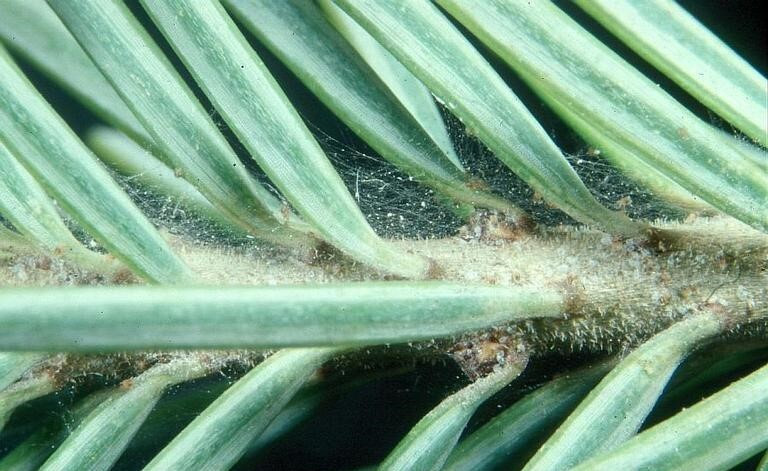Spruce Spider Mites (Oligonychus ununguis)

Figure 1. Spruce spider mite infestation on the needles.
Hosts
Spruce, fir, pine, juniper, arborvitae, Douglas-fir, and yew trees.
Damage and Symptoms
The spider mite is a sap-sucking arthropod, and its feeding results in flecking and grayish spots. Mites usually attack the older needles in the lower portions of the tree. With heavier infestations, needles will prematurely drop, and stunting of the needles can occur. Silk can also be evident on the needles.
Life Cycle
Eggs hatch in the spring, and they develop into adults in about a month. The mites are dormant in the warmer months and are more of a cool-season pest. There are typically two generations per year.
Management
Spider mites respond to stressed trees. If practical, increase the humidity on the trees by jetting them with water on a regular basis. Mites have several natural enemies, such as predatory mites, plant bugs, and spiders to help control them. Insecticides are often ineffective with mite control because the mites have developed resistance, and the insecticides can kill their beneficial natural enemies. Miticides or horticultural oils can be used to effectively control the mites with minimal harm to predators. The best time to treat spruce spider mite infestations is in early spring (April to May) and again in early September (second generation).
Further Information
To learn more about the topics discussed on this page, contact the Schutter Diagnostic Lab. If you suspect an infestation on your property, contact your local extension agent, the Schutter Diagnostic Lab at Montana State University, or the Montana Department of Agriculture.
This fact sheet is also available as a printable PDF (182KB).
Disclaimer: These recommendations are provided only as a guide. It is always the pesticide applicator’s responsibility, by law, to read and follow all current label directions for the specific pesticide being used. The authors and Montana State University assume no liability resulting from the use of these recommendations. The Montana State University Extension Service is an ADA/ EO/AA/Veteran’s Preference Employer and Provider of Educational Outreach.
